
Your Rotary Screw Compressor Airend: Where the Magic Happens
April 30, 2025
Lean Manufacturing & Kaizen in Compressed Air Systems
May 14, 2025The Role Rotary Screw Air Compressors Play in a Disaster
Kaishan USA | May 7, 2025| Uncategorized

Air compressors and compressed air systems play a crucial role in disaster recovery efforts worldwide.
We’ve all seen the news footage of flood-damaged, tornado-ravaged landscapes. Buildings splintered. Roofs torn off. Massive trees blocking highways. Power lines down.
For years, compressed air has helped in those tragic scenarios, providing safe, portable power to help move debris, remove obstacles and support rescue and emergency medical facilities. It’s even been used to pump water, a critical element of flood and storm recovery.
In the rush to restore power after a disaster, compressed air ensures the safety and reliability of key power-generation functions such as operating pneumatic instruments and controls, atomizing fuel, cooling critical equipment, handling ash and starting up engines and turbines.
Let’s discuss how different types of air compressors can help preserve life and property in disasters. We’ll start with the role portable compressors play.
Portable Compressors to the Rescue!
As emergency crews rush to a disaster area, they often bring air compressors to provide the brute force needed to operate equipment.
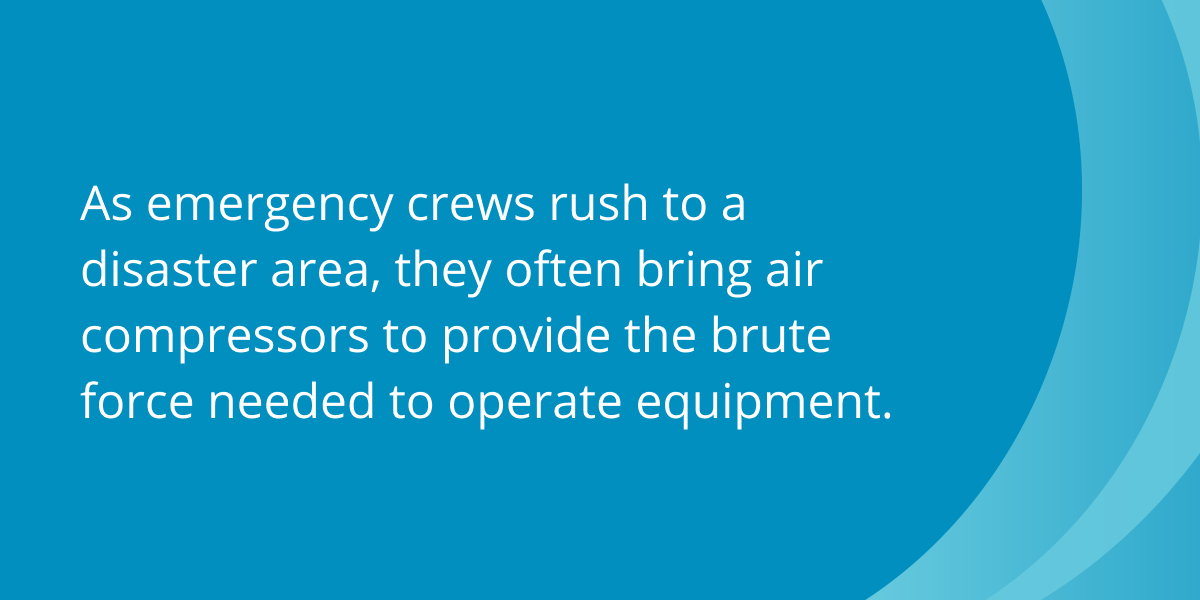
Many of these compressors are diesel-driven, making them the go-to power source when the power grid is down.

Downed powerlines complicate disaster response, blocking roads and denying the power needed for recovery.
Portable diesel compressors are an important, flexible alternative for emergency replacements, short-term needs and point-of-use applications. Over the years, they’ve proved invaluable in mining, rock drilling, sandblasting, construction and, of course, disaster scenarios.
After all, you can move a portable around to service uses like cutting tools, jackhammers, pneumatic drills, nail guns, impact wrenches and pressure washers. But diesels have many drawbacks.
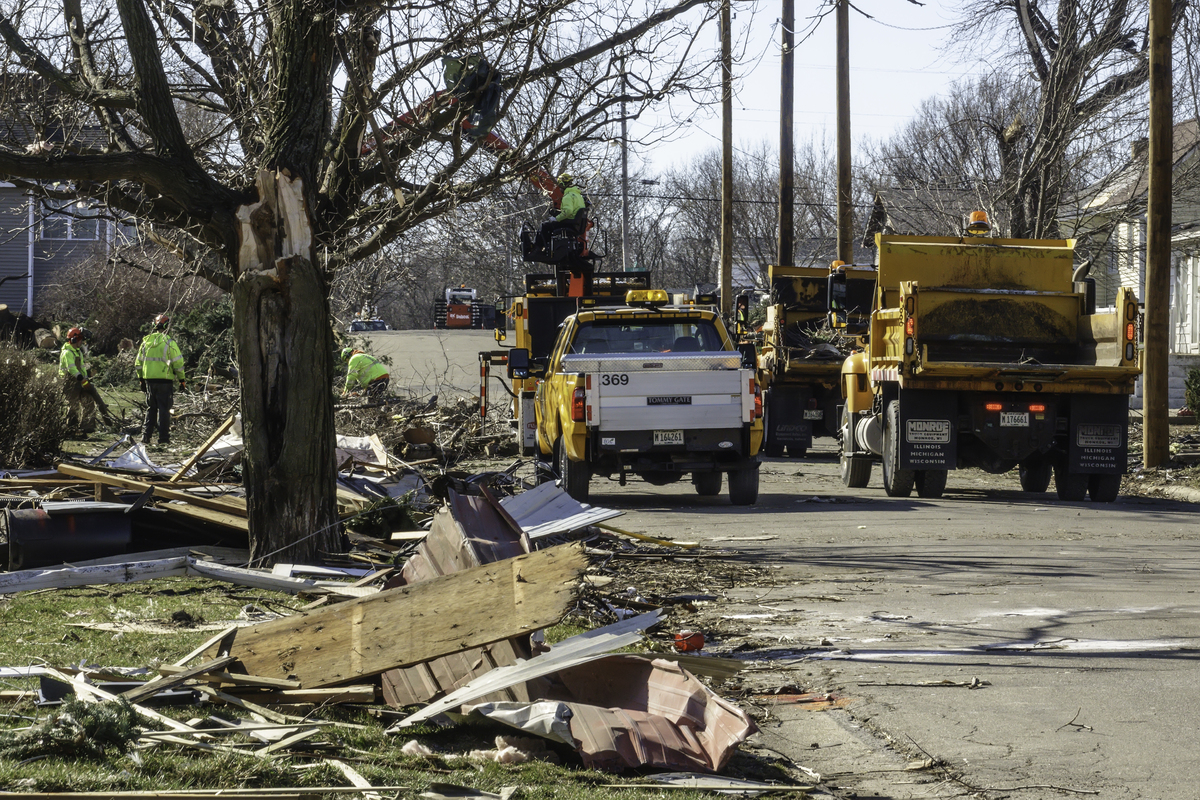
Compressed air is an essential power source for the heavy equipment required for disaster relief efforts.
Depending on the fuel price, diesel compressors cost at least four times more to operate. Plus, they produce emissions, and the air is of lower quality.
There are also significant maintenance costs. A portable diesel compressor will need oil and filters every 250 hours. If you’re operating 24/7, that could mean they require maintenance every ten days. And then there’s the problem of supplying the unit with diesel fuel every 12 hours.
Of course, those issues are less important in true emergencies like natural disasters. The good news is that other options are now available.
Kaishan’s New Portable Electric
One alternative to diesels is Kaishan’s upcoming, electric-driven KRSR portable rotary screw air compressor, a standard compressor on a heavy-duty, rigid skid. You can place it with a forklift or even drag it around. You can get it on a trailer. Or move it around with a crane, using its built-in lifting hook.
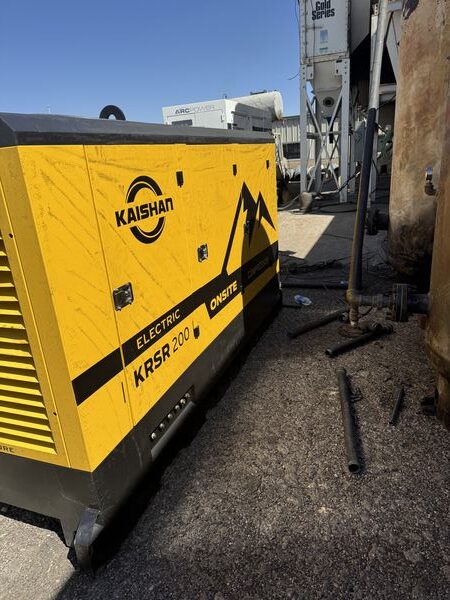
Our new KRSR portable rotary screw air compressor shown here in action.
This new portable electric unit will be designed to handle all environments, including rain, snow or sleet. All elevations, clearly outperforming diesels at higher altitudes. And all temperature extremes from high temperatures to sub-freezing. With appropriately sized cooling and temperature ratings on the liquid-cooled motor, heat tracing and sump heaters for cold temps, it’s a superhero in rugged environments, such as those in a disaster-stricken area. Perfect for the demands of emergency crews.
KRSR is also ideal for getting a factory up and running with compressed air while the plant is rebuilding or cleaning the inside of its facility. Often, the compressed air room is cleaned last, with electricity running to a portable unit outdoors.
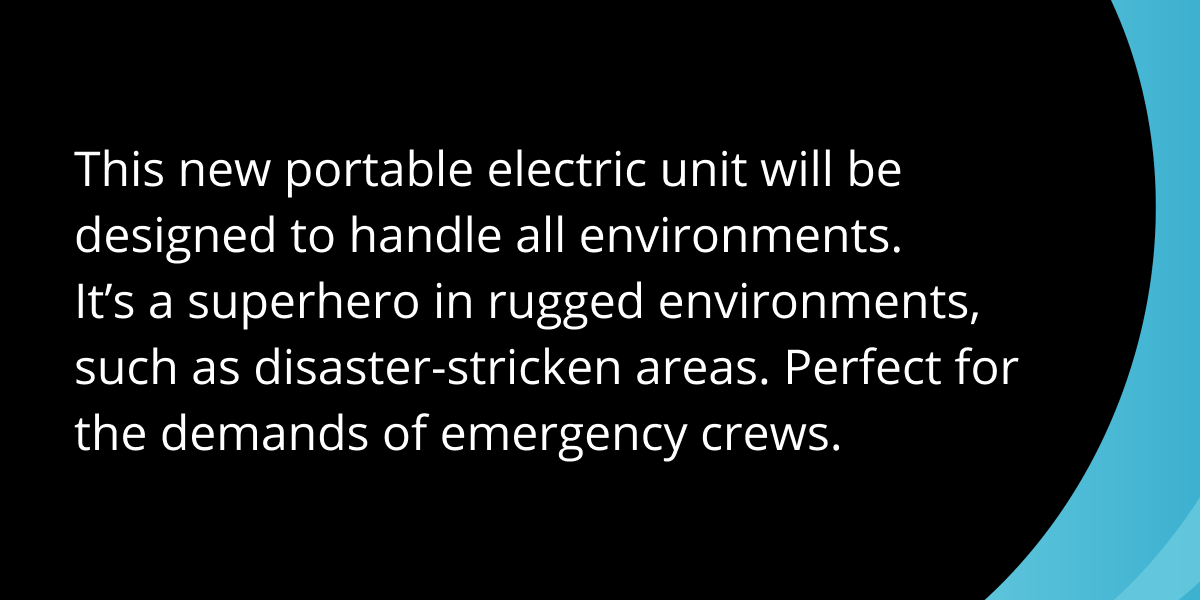
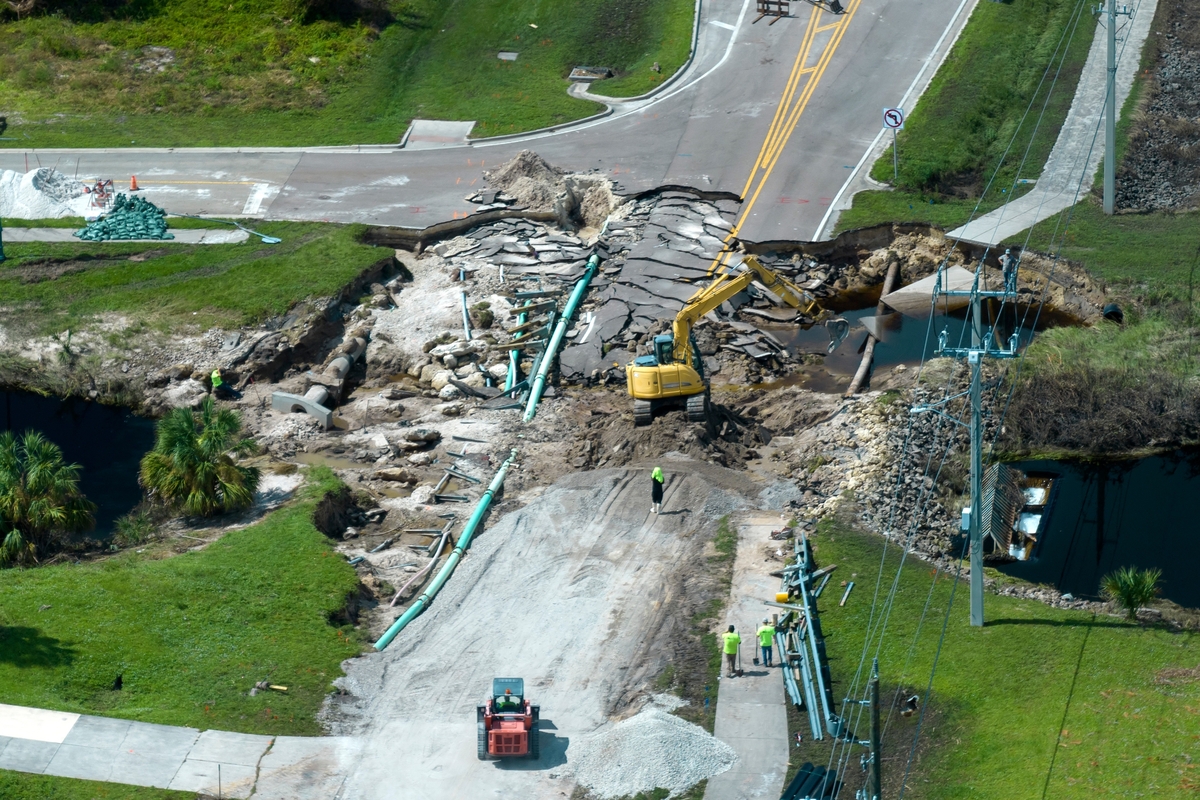
Disaster relief efforts often are complicated by the destruction of critical infrastructure.
It offers several important innovations, including:
- Next-generation variable-speed drive. Our new portable will be equipped with a next-generation variable-speed drive that addresses some of the issues that cause problems for the VSD air compressors currently available. Until recently, we did not recommend using VSDs in industrial environments where the air was heavy with dust and dirt. However, newer, liquid-cooled VSD drives are now coming on the market and may alleviate some of the problems associated with airborne contaminants (the clogging of the heat exchanger mentioned below). For more on the current state of variable-speed drive air compressors, read our blog post, “How Variable-Speed Drive Rotary Screw Air Compressors Save You Money.”
- Liquid cooling. Our new portable unit has liquid cooling not only on its variable-speed drive but also on its electric motor. There is still a heat exchanger that can get clogged, of course. But it is much easier to clean than the heat exchanger of an air-cooled unit. So, rather than having a heat sink on the electronics board that needs cleaning, the new unit has an intermediary cooling fluid circulating through a traditional heat exchanger, making it safe to wash or clean.
- Efficient operation. Our new portable will be versatile and much less expensive to operate than a diesel unit. For example, a 100-HP unit can run at 75 HP if that’s all you need (or all your electrical service can handle). It won't require a completely different unit. If you need 150 PSIG rather than 100 PSIG, you change the speed setting; it’s that simple. You speed it up or slow it down by reducing the power input. It has four different frames to meet almost every need from 200 to 1,500 CFM, and it operates on traditional 460-volt, three-phase electrical current. Most users already have service pods or electrical power available for outside use, so they will find the new compressor a cost-effective and environmentally friendly alternative to diesels.
- Unprecedented flexibility. Best of all, our new portable will have great operational flexibility. You can easily adjust pressure (PSIG) and flow (CFM) to match your needs without sacrificing energy efficiency. The unit’s VSD can regulate the compressor’s speed up and down, allowing it to produce the optimum pressure profile for the demand. And it can reduce speed and save power when there is a less demand.
In addition to portable electric compressors, traditional rotary screw air compressors have a role in emergency response and preparedness.
Rotary Screw Air Compressors Can Help
Our traditional rotary screw compressors also play a role in disaster preparedness in today’s facilities.
First, when paired with adequate reserve tanks, they are a source of stored energy when the power grid is first down. They can provide power for any number of tasks, including debris removal, cleanup or repair jobs. And help restore your plant to safe operation more quickly.
Second, they already drive the control systems in many power generation plants, even nuclear power plants, providing a consistent power source even when electrical service is spotty.
Third, compressed air avoids some of the hazards that electricity and gas can present in environments with volatile gases or other materials in the air.
Fourth, rugged and reliable rotary screw compressors are proven performers in harsh environments, including exposure to water, dust and extreme temperatures.
The good news? Kaishan has hundreds of units in stock in our Loxley, AL facility, ready to ship in almost any emergency. And a great way to avoid costly rentals.
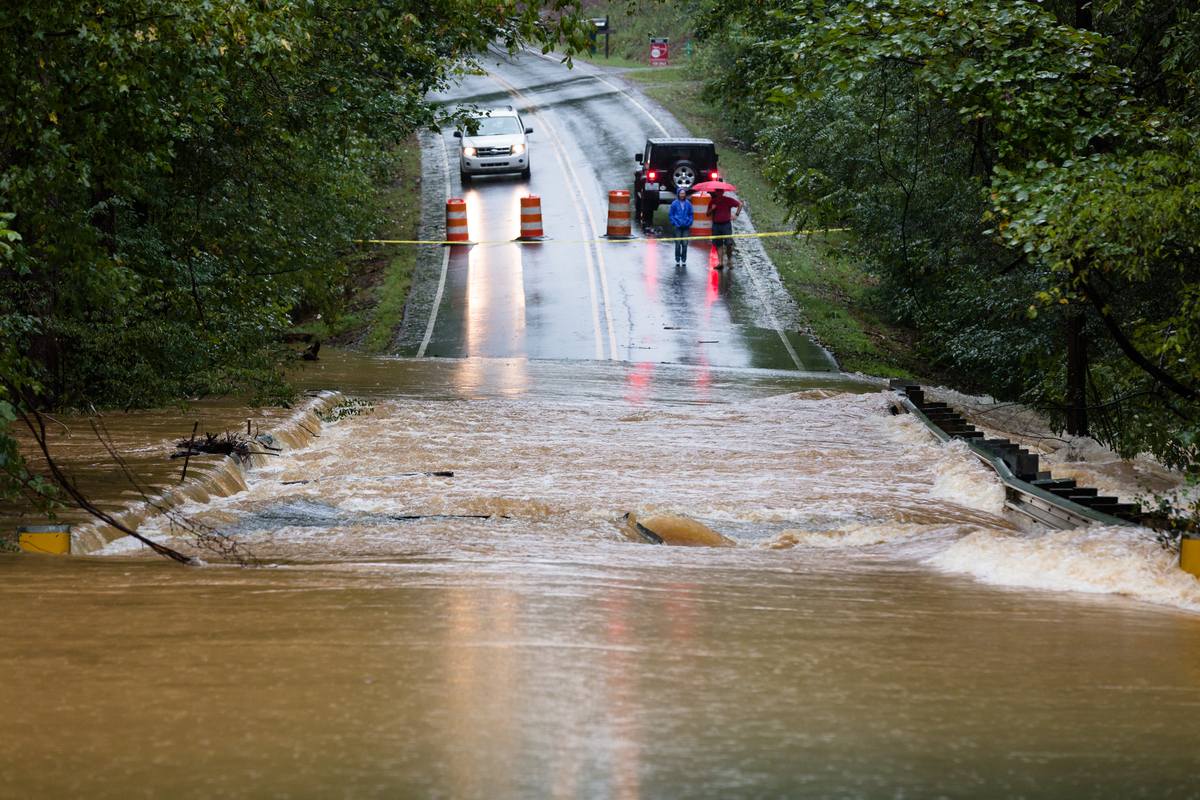
Air compressors and compressed air can handle the rugged conditions that emergency crews often face.
Prepping Your Facility for Emergencies
If your facility was damaged by flooding or other high-water event, we strongly recommend that you contact your local compressed air consultants before firing up your compressor. They can do an overall maintenance check, replace consumables and determine if the inlet filter was damaged or the oil was contaminated. A quick PM call could be very beneficial, preventing serious damage.
One key indicator of a problem: If a compressor is drawing excessive amounts of current, there’s an issue of some sort. Unlike competitive units, Kaishan displays the amps on the control screen.
Whether you’re talking about large regional disasters, smaller local emergencies or outages or problems within your plant, it’s a good idea to have an industrial disaster recovery plan in place. One of the most important elements of an industrial disaster preparedness plan is having a reliable backup air compressor.
Ideally, most facilities will benefit from adopting a multi-compressor approach involving base, trim and backup units, as follows:
- A base load compressor to meet your system’s minimum compressed air load. Its output does not fluctuate as demand goes up and down. Instead, it runs full bore—at 100% of capacity—or it turns off. Depending on variations in your demand, you may have more than one unit as a base load.
- A trim compressor to handle fluctuations in demand above the base unit. Since the level of flow needed will rise and fall depending on the needs of your system, rotary screw compressors equipped with variable-speed drives are a natural for this application.
- A backup air compressor on standby if a base or trim unit goes offline. To fill in appropriately, it should be the same size as the base load compressor.
Some customers avoid using a trim unit by relying on a VSD air compressor to cover the variations in load. We strongly encourage these facilities to build in at least some form of backup. For example, adding a quick connection to a portable compressor, such as Kaishan’s KRSR portable electric rotary screw air compressor, allows for maintenance or emergency service if their compressor goes down. In fact, adding quick connection to a portable unit is a good practice in any system where compressed air is crucial to your operation.
Configuring your compressed air system in this way virtually eliminates unplanned downtime, which, in the real world, is the biggest (and most avoidable) expense associated with your compressed air system. A highly reliable rotary screw air compressor always waits in the wings as a backup should a base load or trim unit fail, keeping both pressure (PSIG) and flow (CFM) more consistent and reliable.
We discuss multiple compressor configurations in greater detail in our blog post, “How Energy-Efficient Air Compressors Can Reduce Your Carbon Footprint.”
We strongly recommend that every facility work with its local compressed air professional to plan for backup service and incorporate its compressed air system into its industrial disaster recovery planning.
Get Help from Your Local Consultant
A trusted compressed air professional can help you assess your facility’s needs for a backup air compressor and other measures to enhance its capabilities in an emergency.
We partner with a nationwide network of independent distributors, who can provide on-site help and consultation as needed and help you prepare for and anticipate any issues that might arise in an emergency. They have rental units they can have up and running on your site very quickly.
We’ve chosen to work with these independent, local distributors because they can offer you expert guidance, faster response times and personalized support tailored to your needs.
They have factory-trained technicians and a deep understanding of industrial applications, a huge help when there’s a problem. When you buy through Kaishan, you're getting more than a product—you're getting a local partner who cares about your business and seeing it succeed.
Key Takeaways
- Compressed air provides safe, portable power to help emergency crews move debris, remove obstacles and support rescue operations and medical facilities.
- Portable diesel compressors are an important, flexible alternative for emergency replacements, short-term needs and point-of-use applications, but they have many drawbacks.
- One alternative to diesels is Kaishan’s upcoming KRSR portable rotary screw air compressor, a standard compressor on a heavy-duty, rigid skid.
- Our traditional rotary screw compressors also play a role in disaster preparedness in today’s facilities.
- We encourage customers to add a backup air compressor, adopting at least a three-compressor approach involving base, trim and backup units.
- We strongly recommend that every facility work with its local compressed air professional to plan for backup air compressors and incorporate its compressed air system into its industrial disaster preparedness planning.
Let Us Help
Incorporating your rotary screw air compressor and your compressed air system into your industrial disaster preparedness plan can be a critical step in restoring the operation of your compressed air system and all the processes that rely on that system. And, of course, in helping your entire enterprise recover from a disaster. If you need help deciding how to prepare for an emergency, get in touch with the experts at Kaishan. Contact us today.
Listen to the Podcast Version
Air Power in Disaster Recovery
Coming at you like a wild storm in the wilderness, it's the Kaishan Big Dog podcast! Welcome back, everyone.I see what you did there, Lisa! Speaking of which, when disaster strikes—floods, tornadoes, you name it—what's the first thing emergency crews need? Power.
Right, and not just any power. We're talking about portable, flexible solutions that can handle everything from clearing debris to keeping medical equipment running when the power grid is down.
Exactly. And that's where compressed air systems come in. These things have become a cornerstone in disaster recovery. Take, for example, debris removal. You’ve got blocked roads, collapsed buildings—that’s where compressed air tools like jackhammers and saws play a key role.
And it’s not just tools. Compressed air powers pumps that help remove floodwaters or support medical tents with clean air supply. It’s like a Swiss Army knife for disaster zones.
Yeah, yeah. It's tough to think of a single scenario where you wouldn’t find these systems helping out. I mean, I saw footage from a tornado-stricken town where crews were using air compressors to cut through fallen debris—it was the only way to clear the roads for rescue vehicles to even get through.
Wow. There was actually a plant manager I spoke to last year. Their facility got slammed by a severe storm—trees down, everything. The entire place was offline. But they had this rotary screw backup compressor on standby, ready to go. That compressor? It kept their recovery on track until power was restored.
That’s the benefit of having backup compressors, right? With the way disasters impact infrastructure, you can’t rely solely on the grid to bounce back in time. You need adaptable solutions ready to step in.
And resilient ones, too. Traditional rotary screw compressors, for instance, are built to handle the worst conditions—water, dust, extreme temperatures. They just keep going.
Which makes them ideal in these high-stakes situations. But here’s where it gets tricky...
Diesel vs. Electric: The Cost of Power
So here’s where it gets tricky—diesel compressors. They’ve been a mainstay in disaster response for years, but when infrastructure is down and fuel supply chains are disrupted, they can quickly become more of a challenge than a solution.You mean the costs, right? Maintenance, fuel—it all adds up, especially when you’re running them 24/7 in an emergency situation.
Exactly. Just to put it in perspective, fueling up those things every 12 hours isn’t cheap. And that’s assuming you can even get diesel delivered to a disaster zone. Roads? Often blocked. Supplies? Scattered. It can turn into a logistical nightmare.
And then there are the emissions. I mean, in the middle of an environmental crisis, adding pollution to the mix just feels… counterproductive.
Totally. That’s where electric rotary screw compressors like Kaishan’s KRSR really start to shine. They're not just cleaner. They’re cheaper and way more efficient over the long haul.
Yeah, like with diesel, the maintenance alone—filters and oil every 250 hours—it’s constant. But the KRSR? Fewer moving parts, longer intervals, and the flexibility to adjust output as needed. It’s built for emergencies.
And let’s not forget portability. Diesel units have their perks—they’re rugged and reliable. But the KRSR? It’s designed to handle all terrains, even harsh conditions like extreme cold or high altitudes. Plus, it’s electric, so you’re not chained to a fuel delivery schedule.
That’s huge. Especially when you factor in its variable-speed drive. It’s not stuck at full power if you don’t need it. You can dial it down, save energy, and still get the job done.
Right, it’s all about operational flexibility. Need higher pressure? Adjust the settings. Less flow? Same deal. It adapts to what the moment demands, no wasted power.
It’s kinda like having a Swiss Army knife that also happens to be eco-friendly and cost-effective.
And that’s a game-changer. Especially when you compare both options in an emergency—one’s stuck requiring constant fuel and maintenance, while the other keeps running, no strings attached.
Building Resilient Systems for the Next Emergency
Alright, so thinking back to those challenges with diesel and the advantages of electric systems, it all comes down to one key takeaway—preparedness. When disaster strikes, you don’t want to be scrambling to figure out how to power your facility effectively.Exactly. And this is where having a strong backup plan for your compressed air system makes all the difference. You can’t just rely on the grid snapping back immediately.
Nope, you’ve gotta have a system in place. Take this: a multi-compressor setup—base, trim, and backup units. It’s all about redundancy. If one fails, the others step in. It’s like an insurance policy for uptime.
It’s a no-brainer. And what’s even more crucial is working with local air pros to get it right. They're the ones who know your environment and can tweak the system to handle whatever’s coming your way.
Yeah, and don’t overlook maintenance. Routine checks, keeping a backup unit ready to go—it’s the small steps that can save you massive headaches when things go sideways.
There’s actually a great example of this. A nuclear power plant—talk about high stakes, right? They had a tailored backup air solution ready to go. When they were hit by a regional outage, the backups kicked in instantly. Zero downtime. That’s what makes the difference.
See, that’s what I mean. It’s not just equipment; it’s having a plan. A solid disaster recovery plan with the right compressed air setup could keep your facility running when nothing else can.
And the quick rental options from Kaishan’s distributor network? Those come in clutch too. They can have a unit on-site faster than you think, keeping recovery efforts on track.
So, bottom line—having resilient systems in place isn’t optional anymore. It’s the only way to minimize downtime and losses when things go wrong.
And with that, I think we’ve covered a lot today. Emergency preparedness, the tech, the practical steps—it’s all about staying one step ahead.
Couldn’t agree more. And that’s all for today’s episode of The Big Dog Podcast. Stay prepared out there.
Thanks for tuning in, everyone. Until next time!
Random stat or
customer quote
textXXtext
text

